Romeo Montague(Italian:Romeo Montecchi) is the maleprotagonistofWilliam Shakespeare'stragedyRomeo and Juliet.The son ofLord Montagueand his wife,Lady Montague,he secretly loves and marriesJuliet,a member of the rival House of Capulet, through a priest namedFriar Laurence.
| Romeo Montague | |
|---|---|
| Romeo and Julietcharacter | |
 The balcony scene inRomeo and Julietas depicted byFord Madox Brown(1869-70) | |
| First appearance |
|
| Created by | Luigi da Porto,William Shakespeare |
| Based on | Romeus, fromThe Tragical History of Romeus and Juliet(1562) |
| In-universe information | |
| Affiliation | |
| Family |
|
| Spouse | Juliet Montague |
| Nationality | Italian |
Forced into exile after slaying Juliet's cousin,Tybalt,in aduel,Romeo dies bysuicideupon hearing falsely of Juliet's death.
The character's origins can be traced as far back asPyramus,who appears inOvid'sMetamorphoses,but the first modern incarnation of Romeo is Mariotto in the 33rd ofMasuccio Salernitano'sIl Novellino(1476). This story was reworked in 1524 byLuigi da PortoasGiulietta e Romeo(published posthumously in 1531). Da Porto named the character Romeo Montecchi, and the storyline is nearly the same as Shakespeare's adaptation.[1]Since no 16th-century direct English translation ofGiulietta e Romeois known, Shakespeare's main source is thought to beArthur Brooke'sEnglish verse translationof a French translation of a 1554 adaptation byMatteo Bandello.[2]Although both Salernitana and da Porto claimed that their stories had a historical basis, there is little evidence that this is the case.
Romeo, an only child like Juliet, is one of the most important characters of the play and has a consistent presence throughout it. His role as anidealisticlover has led the word "Romeo" to become a synonym for a passionate male lover in various languages. Although often treated as such, it is not clear that "Montague" is a surname in the modern sense.
Origins
editThe earliest tale bearing a resemblance toShakespeare'sRomeo and JulietisXenophon of Ephesus'Ephesiaca,whose heroic figure is a Habrocomes. The character of Romeo is also similar to that ofPyramusinOvid'sMetamorphoses,a youth who is unable to meet the object of his affection due to an ancient family quarrel, and later kills himself due to mistakenly believing her to have been dead.[3]Although it is unlikely that Shakespeare directly borrowed from Ovid while writingRomeo and Juliet,the story was likely an influence on the Italian writers whom the playwright was greatly indebted to.[4]The two sources which Shakespeare most likely consulted are Brooke's translation of da Porto andWilliam Painter'sThe goodly historye of the true, and constant Love between Romeo and Juliet.[5]
Film portrayals
editRomeo and Juliethas been adapted into film several times, and the part of Romeo has been played by several actors, including
- Leonard WhitinginFranco Zeffirelli's 1968 film,Romeo and Juliet,oppositeOlivia Husseyas Juliet.
- Leslie HowardinGeorge Cukor's 1936 film,Romeo and Juliet,oppositeNorma Sheareras Juliet.
- Laurence HarveyinRenato Castellani's 1954 filmRomeo and Juliet.
- Leonardo DiCaprioinBaz Luhrmann's modernized 1996 version,Romeo + Juliet,alongsideClaire Danesas Juliet.
- Douglas BoothinCarlo Carlei's 2013Romeo and Julietfilm adaptation, oppositeHailee Steinfeldas Juliet.
- Orlando Bloomin aBroadwayadaptation in 2013.
- Jordan Luke Gagein theWest Endmusical& Juliet.
- Kyle Allenplays the character inRosaline(2022 film).
- Kit ConnorinSam Gold's 2024 Broadway adaptation.
Other portrayals
edit- Nice Peterin an episode of the YouTube comedy seriesEpic Rap Battles of History.
References
edit- ^da Porto, Luigi(1868). "The Original Story of Romeo and Juliet". In Pace-Sanfelice, G. (ed.).The original story of Romeo and Juliet by Luigi da Porto. From which Shakespeare drew the subject of his drama. Being the Italian text of 1530, and an English translation, together with a critical preface, historical and bibliographical notes and illustrations.Translated by Pace-Sanfelice, G. Cambridge: Deighton, Bell, and co.hdl:2027/mdp.39015082232961.
- ^Hunter, Lynette; Lichfield, Peter (2009).Negotiating Shakespeare's language in Romeo and Juliet: reading strategies from criticism, editing and the theatre.Farnham, England: Ashgate Publishing. p. 93.ISBN978-0-7546-5844-3.
- ^Halio, Jay (1998).Romeo and Juliet: A Guide to the Play.Hoboken, New Jersey:Blackwell Publishing.p. 93.ISBN1-4051-1396-0.
- ^Bevington, David M. (2006).How to read a Shakespeare play.Westport, Connecticut:Greenwood Press.p.37.ISBN0-313-30089-5.
- ^Hunter & Lichfield, p. 11
Bibliography
edit- Shakespeare, William (1859).Romeo and Juliet:A tragedy.Leipzig: G. Græbner.